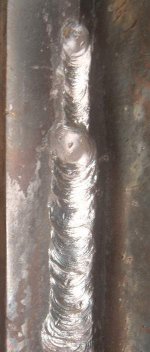You are using an out of date browser. It may not display this or other websites correctly.
You should upgrade or use an alternative browser.
You should upgrade or use an alternative browser.
FEL Mount Cracks
- Thread starter mmranch
- Start date
- Views: 4842
More options
Who Replied?
/ FEL Mount Cracks
#11
Sberry
Platinum Member
On this kind of joint the rod doesnt have much to do with penetration, not really. Yes, the 10 and 11 dig a little but mauinly they freeze fast to allow for control in a joint properly designed to allow for penetration.
The arc is more aggressive, it does cut thru crud a little easier but 7018 is so much better on dirty steel as the flux is so haevy it carries away so much more contamination and the pool so much less violent and slower freezing it lets the crud float out. Second pic was meant to show how agressive it can be, right on the verge of melting thru the 1/4 in a T and able to restack it.


The arc is more aggressive, it does cut thru crud a little easier but 7018 is so much better on dirty steel as the flux is so haevy it carries away so much more contamination and the pool so much less violent and slower freezing it lets the crud float out. Second pic was meant to show how agressive it can be, right on the verge of melting thru the 1/4 in a T and able to restack it.
LouNY
Super Star Member
- Joined
- Jul 4, 2015
- Messages
- 14,070
- Location
- Greenwich, NY
- Tractor
- Branson 8050, IH 574, Oliver 1550 Diesel Utility (traded in on Branson) NH 8160. Kioti CK2620SECH
I've had do a bit of loader repair myself. The factory loader on the farms PUMA 125Agree....6010/11 are great digging rods to get full depth.
These cracks are the whole reason factories throw weldments into the oven to stress relieve after welding.
was not built as sturdy as it should have been. It has been repaired numerous times
and it's main job has been digging feed out of ag bags, it has also been used for back blading
some roads ways and mud.
The subframe hasn't given any issues but the main loader joint at the rear attachment point has pulled
out and been repaired and beefed, the pin ends have been pulled off the bucket cylinders and the
bucket cylinder mounts have pulled out of the frame, got some pictures of that repair; all 6011 on an AC welder
Attachments
-
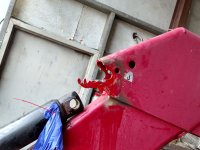 loader 2A.jpg997.7 KB · Views: 253
loader 2A.jpg997.7 KB · Views: 253 -
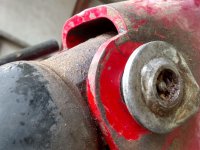 loader 3A.jpg1.1 MB · Views: 271
loader 3A.jpg1.1 MB · Views: 271 -
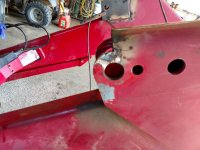 loader 5A.jpg1.2 MB · Views: 263
loader 5A.jpg1.2 MB · Views: 263 -
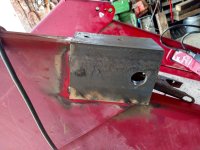 loader 6A.jpg1.1 MB · Views: 227
loader 6A.jpg1.1 MB · Views: 227 -
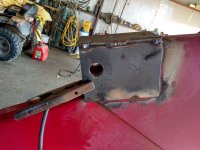 loader 7A.jpg1.1 MB · Views: 244
loader 7A.jpg1.1 MB · Views: 244 -
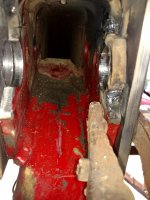 loader 10A.jpg1.2 MB · Views: 233
loader 10A.jpg1.2 MB · Views: 233 -
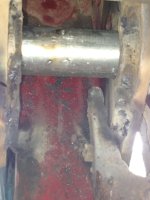 loader 14A.jpg769.5 KB · Views: 220
loader 14A.jpg769.5 KB · Views: 220 -
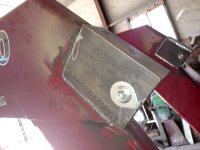 loader 19A.jpg910.6 KB · Views: 208
loader 19A.jpg910.6 KB · Views: 208 -
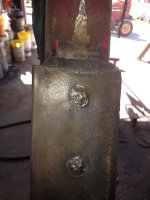 loader 21A.jpg989.6 KB · Views: 232
loader 21A.jpg989.6 KB · Views: 232 -
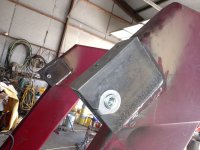 loader 23A.jpg1 MB · Views: 242
loader 23A.jpg1 MB · Views: 242
Last edited:
MinnesotaEric
Super Member
I'm in the camp that says that no matter your skill level, you should give it a go. Get a few hard disks for your grinder, V out the cracks, hit the root pass with 6010 and everything else too. Grind that root pass a bit until smooth, and rinse and repeat until flush with the surface.
If your welding stinks, then grind the poor weld out and try it again, hopefully improving. Stringer welds are stronger so don't do any weaving even if as a top finish, the weave looks better.
If your welding stinks, then grind the poor weld out and try it again, hopefully improving. Stringer welds are stronger so don't do any weaving even if as a top finish, the weave looks better.
Last edited:
mmranch
Gold Member
Thanks to all for the ideas, encouragement, photos and links! I a trying to weld it myself and am learning a lot in the process. In honor of Halloween... my results are pretty scary but I'll keep grinding away at it.
Thanks again.
Thanks again.
JDAOWNER
Silver Member
REMEMBER IF WELDING ON A PIECE THAT IS ATTACHED TO THE TRACTOR ( OR ANY MACHINE) KEEP YOUR GROUND LEAD CLOSE TO THE WORK LEAD. DON'T--DON'T-- WELD WITH THE LEADS ON OPPOSITE SIDES OF A BERING OR PARTS THAT MOVE. KEEP THEM CLOSE.
pacosperson
Bronze Member
My guess is the "2" crack in 1/2" plate occurred because the materials were not stress relieved after the first welding at the factory. A "professional" welder will know how to stress relieve the parts and prevent future problems. Improperly relieved parts can pop a crack just setting on a bench after welding. (cold bench, hot parts, uneven cooling) It is amazing.Thanks for the ideas! Here's a photo showing the mount and cracks. The mount is now off the tractor.
The crack in the 1/2" plate is pretty easily accessible on both sides for grinding and welding.
The crack in the 5/8" plate is hidden in the photo on the opposite side of the mount and is in a location that the grinder can't get to. I'm currently using hand files and Dremel to try and clean the paint from this area. Cutting a groove in this area will be difficult.
Thanks again.
panamaguy
Silver Member
- Joined
- May 18, 2020
- Messages
- 188
- Tractor
- kubotab7001 ... IHI NX15 excavator
As a now retired professional welder all my life I would v it out and use 6010 for the root pass and then 7018 for the hot pass (2nd) and also the cap. Remember that you can not down hand 7018. Grind or power wire brush the 1st (root pass) and then chip the slag and power wire brush the 2nd pass clean before doing the cap. So do the root and one hot pass then flip it over and grind the back side of the root pass. (100% penetration) From there if you want you can use 7018 totally on the back side. Do not let the Flux get ahead of you with 7018 or it will be trapped in the weldI've got two cracks developing in one of my FEL mounts.
One crack is in the edge of a piece of 1/2" steel plate (it is an 8" wide 1/2" thick plate with a 2" crack perpindicular to the edge which moves inward to the center of the plate. The hairline crack is all the way through both sides of the plate).
The other crack is in the edge of a piece of 5/8" steel plate and is about 1" long on both sides of the plate.
I've got two options. One is I have my local welder weld it but he can't get to it for a couple of weeks. The other is I try to weld it myself to be ready for the coming snow in a couple days. But my welding skills are no where near as good as his.
If I do it... I'm thinking I would need to grind a V groove over the crack on both sides of the plate and stick weld it with 7018? High amps for penetration of metal this thick?
Thanks for any thoughts!
. If you are new to welding and can set the part so you are welding on a slightly up hill slope that will help you keep ahead of the Flux. If the part is small enough to bury it in floor dry or cat litter and let it cool slowly that is also good.
panamaguy
Silver Member
- Joined
- May 18, 2020
- Messages
- 188
- Tractor
- kubotab7001 ... IHI NX15 excavator
Good adive and always disconnect the battery to stop from frying and circuit boardsREMEMBER IF WELDING ON A PIECE THAT IS ATTACHED TO THE TRACTOR ( OR ANY MACHINE) KEEP YOUR GROUND LEAD CLOSE TO THE WORK LEAD. DON'T--DON'T-- WELD WITH THE LEADS ON OPPOSITE SIDES OF A BERING OR PARTS THAT MOVE. KEEP THEM CLOSE.
mmranch
Gold Member
Thanks for all the thoughts on this. I completed the crack repairs and then added some reinforcement on the bigger crack areas. I'll see how it holds up over time.
Thanks again.
Thanks again.
